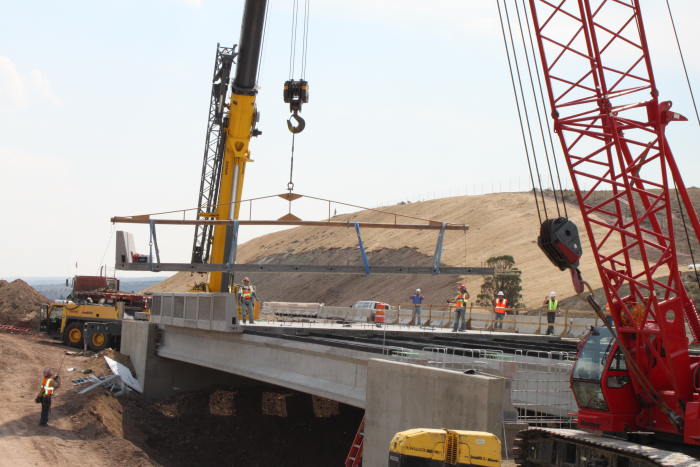



ユタ州運輸局は、橋のデッキにガラス繊維強化ポリマー (GFRP) 製のロッドを使用することが橋の寿命に与える影響を調査しています。GFRP ロッドは融雪剤による腐食に耐えるため、デッキの寿命を 45 年から 100 年に延ばすことができます。耐腐食性は、橋のデッキの長期的なコストを削減する最大の要因です。ビーバー クリーク橋は、プレストレスト コンクリートの桁と GFRP バーで補強されたプレキャスト コンクリートのデッキ パネルを使用した加速橋建設法で建設されました。
ユタ大学(U of U)は、建設中に橋に計測機器を設置し、新しい建設資材と建設方法が必要な性能を発揮するかどうかを判断するためのテストを実施しました。
テストは建設段階から始まり、建設完了後も継続されました。デッキパネル 2 枚の GFRP ロッドには鋳造前に箔ひずみゲージが取り付けられ、パネルが持ち上げられるたびにデータロガーがひずみデータを記録しました。パネルが橋の所定の位置に設置されると、バイブレーティングワイヤひずみゲージ (VWSG) が取り付けられ、次のデータが記録されました。
- ポストテンションによるひずみ
- トラック積載試験中のひずみ
- クリープやその他の長期的要因によるひずみの変化
ユタ大学の研究者は、いくつかの桁の底部に取り付けられた加速度計を使用して、次のことを行いました。
- トラック積載テスト中に最高加速度を記録
- 長期モニタリング中に加速度のシグネチャを記録する
- カメラを起動する
カメラは、最大の加速度測定値を引き起こした車両の画像を記録しました。
研究者らはまた、デッキのたわみを測定するために、桁間のダイヤフラムの上に線形可変差動トランスデューサー(LVDT)を設置した。また、荷重試験中は、測量機器を使用して桁のたわみを測定した。
このプロジェクトでは、AVW200 バイブレーティングワイヤ インターフェイス (VWSG からの信号を管理するため)、AM16/32A マルチプレクサ 3 台、CR3000 マイクロロガー 2 台、CR1000 データロガー 1 台を使用しました。デッキ パネルの持ち上げと輸送中、データロガーは記録されたデータを RF401 無線を使用してラップトップに送信しました。トラックの負荷テストでは、データロガーはラップトップに直接接続されました。プロジェクトの長期監視部分では、セル モデムがデータロガーをインターネットに接続し、インターネットにアクセスできる場所であればどこからでもデータを取得できるようにしました。
収集されたデータには、デッキパネルのコンクリートのひずみ、桁に対するパネルの相対変位、垂直加速度が含まれます。曲率、変位、加速度のパラメータを使用して、テスト結果を設計要件やコンピューター生成モデルの有限要素解析と比較することにより、デッキと桁の応答に関する結論が導き出されました。
コンピュータで生成された橋のモデルは、デッキパネルの曲げ応答、車両の位置に対する動的応答、および中間スパンでの静的相対変位を示しました。 2 年間の運用後、プレキャスト デッキを含む橋の性能は設計要件を十分に満たしていることが示されました。
James Ries、「ガラス繊維強化ポリマーバーで強化されたプレキャスト橋梁デッキパネルの健全性監視」修士論文、ユタ大学、2011 年。